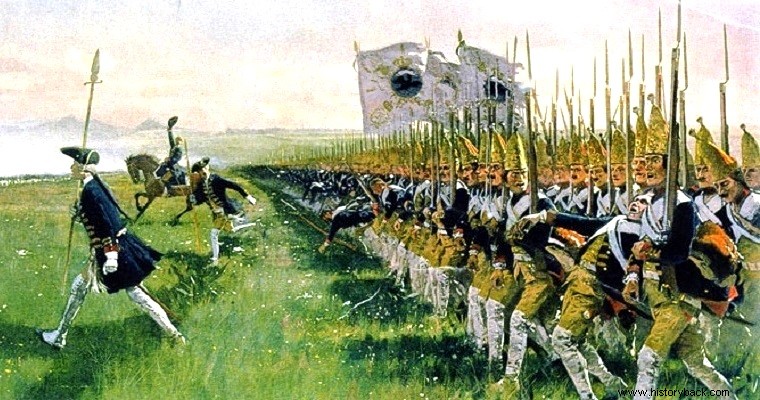
One of the best infantry regiments of all time was the 6th Prussian Grenadier Regiment. The regiment has an extremely interesting history of glory especially during the Seven Years War. The regiment was formed in 1675 and originally had two battalions. A little later it became the bodyguard regiment of the ruler of Frederick. In 1677 he fought against the Swedes in Pomerania, while in 1686 he joined the allied force of the Holy Coalition and acted exceptionally against the Turks in Hungary.
He fought against the French in the War of the Grand Alliance and took part in the battles and sieges of Kaiserwerth, Bonn, Lautsche, Steenkerken, Namur, Ghent and Oudenard. During the War of the Spanish Succession, joining the allied army of Prince Eugene, he took part in the famous battle of Blenheim. In 1710, the so-called "Red Order" was formed, the command of which was taken over by the crown prince and father of Frederick the Great, Frederick William of Prussia. The battalion in question became a model unit based on the tactics of which all Prussian infantry had to be trained and joined the Regiment.
When Frederick II, later the Great, became king, in 1740, two battalions were removed from the regiment and joined with others, one of them in the famous 15th Regiment of Guards. The 6th was left with a single battalion, but retained its regimental title and became a grenadier unit.
Together with the three battalions of the 15th Regiment of the Royal Guards it formed the Guards Brigade. The battalion fought exceptionally well at Hohenfriedberg, 1745 (War of the Austrian Succession or Second Silesian War), suffering 184 casualties. At the Battle of Zoor (1745) the Guards Brigade broke through the enemy centre. When the Seven Years' War broke out in 1756, the battalion was commanded by Colonel von Retzoff. In 1760 he was succeeded by Major General von Zaldem. The battalion/regiment outnumbered the other battalions of the Prussian army, fielding a total of 864.
Seven Years War. The years of glory and blood
With the beginning of the Seven Years' War, the 6th, included in the force personally commanded by King Frederick, participated in the invasion of Saxony. He took part in the deadly battle of Parga (May 6, 1757), the eponymous battle of Rosbach and the famous battle of Luten, the most perfect application of the Oblique Phalanx tactics since the time of Epaminondas and Pelopidas. According to descriptions of the time, the 6th "performed a miracle of bravery", in Luten, fighting in the village of the same name and suffering losses of the order of 27%. At the disastrous battle of Hokirch (October 14, 1758) the 6th again fought heroically, losing nearly half its men.
On the 6th he also fought in the battle of Liegnitz, where he distinguished himself and in the particularly bloody, albeit victorious, battle of Torgau (November 3, 1760) where he suffered losses of the order of 48%. The participation of the 6th in the Seven Years' War ended in the victorious battle of Omsdorf, on July 20, 1762, where it stormed the fortress of the same name. The regiment, with a different number, also fought in the Napoleonic Wars, in World War I, in World War II, while the current Guard Battalion in Berlin traces its origins to the 6th Grenadier.
